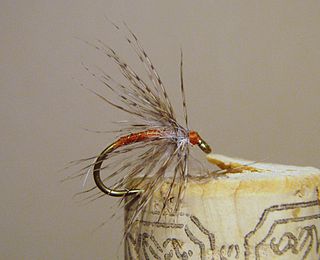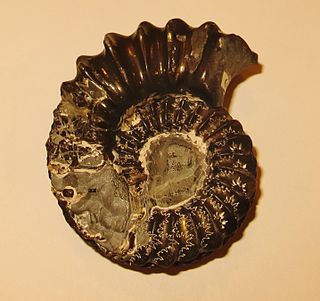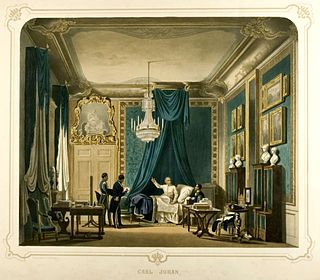
Terebratulids are one of only three living orders of articulate brachiopods, the others being the Rhynchonellida and the Thecideida. Craniida and Lingulida include living brachiopods, but are inarticulates. The name, Terebratula, may be derived from the Latin "terebra", meaning "hole-borer". The perceived resemblance of terebratulid shells to ancient Roman oil lamps gave the brachiopods their common name "lamp shell".

In knitting, ribbing is a pattern in which vertical stripes of stockinette stitch alternate with vertical stripes of reverse stockinette stitch. These two types of stripes may be separated by other stripes in which knit and purl stitches alternate vertically; such plissé stripes add width and depth to ribbing but not more elasticity.

In knitting, a basketweave pattern is characterized by intersecting ribs and welts.

Knitted fabric is a textile that results from knitting, the process of inter-looping of yarns or inter-meshing of loops. Its properties are distinct from woven fabric in that it is more flexible and can be more readily constructed into smaller pieces, making it ideal for socks and hats.
Ribbing is a Swedish noble family of medieval origin. which may refer to:

Adolphe de Leuven was a French theatre director and a librettist. Also known as Grenvallet, and Count Adolph Ribbing.

The Partridge and Orange is an artificial fly commonly categorized as a wet fly or soft hackle and is fished under the water surface. The fly is a very well known fly with its roots set firmly in English angling history. It is an impressionistic pattern fished successfully during caddis hatches and spinner falls. The Partridge and Orange is traditionally a trout and grayling pattern but may be used for other aquatic insect feeding species.
Elizabeth Ribbing, was a Swedish noblewoman and lady-in-waiting. She was the secret morganatic spouse of Prince Charles Philip, Duke of Södermanland.

Hecticoceras is an ammonite genus belonging to the haploceratoid family Oppeliidae, that lived during the Middle and Late Jurassic, from the Callovian. Hecticoceras may be seen as a series of some nine subgenera, beginning with the lower Callovian H. (Hecticoceras) and H. (Hecticoceratoides) and ending with the lower Oxfordian H. (Pseudobrightia) and H. (Eochetoceras). Hecticocerassensu lato and Prohecticoceras from the underlying Bathonian form the oppeliid subfamily, Hecticoceratinae.

Adolph Ludvig Ribbing, later called Adolph de Leuven, was a Swedish count and politician. He participated in the regicide of Gustav III of Sweden in 1792.

Count Gustaf Lagerbjelke. The 3rd Count Lagerbjelke was a Swedish politician, the last Lord Marshal and the first Speaker of Första kammaren of the Riksdag.

Hammatoceratidae is a family of lower and middle Jurassic ammonites included in the superfamily Hildoceratoidea.

Events from the year 1843 in Sweden

Events from the year 1788 in Sweden

Events from the year 1765 in Sweden

Events from the year 1596 in Sweden
Events from the year 1662 in Sweden

PF-610355 is an inhalable ultra-long-acting β2 adrenoreceptor agonist (ultra-LABA) that was investigated as a treatment of asthma and COPD by Pfizer. It utilizes a sulfonamide agonist headgroup, that confers high levels of intrinsic crystallinity that could relate to the acidic sulfonamide motif supporting a zwitterionic form in the solid state. Optimization of pharmacokinetic properties minimized systemic exposure following inhalation and reduced systemically mediated adverse events. Its in vivo duration on action confirmed its potential for once-daily use in humans.

Sofie Amalia Ribbing was a Swedish painter of the Düsseldorf School. She specialized in portraits and genre scenes, often placed in family settings.

Life in the Finnish Woods is a 1947 Swedish drama film directed by Ivar Johansson and starring Carl Jularbo, Naima Wifstrand and Barbro Ribbing. It was shot at the Centrumateljéerna Studios in Stockholm with location shooting around Bollnäs in Eastern Sweden. The film's sets were designed by the art director P.A. Lundgren. It takes its title from a 1913 waltz of the same title by Jularbo, whose signature tune it became.
















